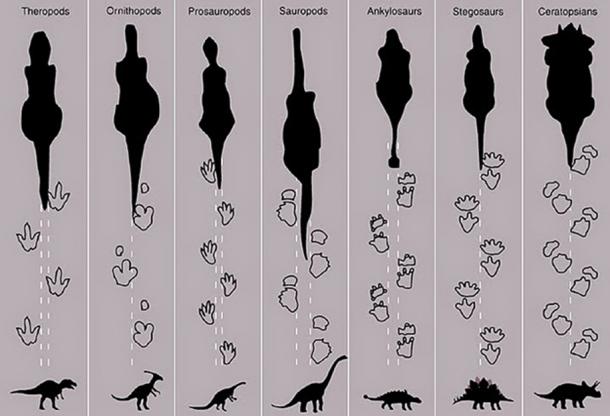
Some ancient rock art shows the deliberate leaving of hand prints by our ancestors leaving a lasting impression of their existence. The surprising prints that are to be found on a rock face in Bolivia were a completely unintentional mark left by unwitting artists. Sometimes a fortunate sequence of events leaves a puzzling phenomenon on the earth. The many dinosaur trails found adorning what appears now as an almost vertical wall is one of those examples.

The dinosaur track wall at Bolivia’s Cretaceous Park. (Source: CC BY 2.0).
Footprints on the wall
Cal Orcko is a site located in the south central Bolivian department of Chuquisaca, close to Sucre, the country’s constitutional capital. The site is home to the Parque Cretácico (meaning ‘Cretaceous Park’), which is renowned for having a wall said to contain the largest concentration of dinosaur footprints in the world. Finding one dinosaur footprint millions of years old is pretty thrilling – but to find 1000s in one place? It has been described by archaeologists as a ‘dinosaur dancefloor’, as layers of footprints create a cross-hatched pattern of trails. Through these footprints, palaeontologists were able to identify some of the various types of dinosaur that once roamed the area, feeding, fighting and fleeing in an ultimately ill-fated competition for survival.

Dinosaurs crossed paths through the ages. (CC BY-NC-SA 2.0)
Disturbing the dinosaurs
Cal Orcko means ‘lime hill’ in the local Quechua language, and is an indication of the rock found at the site, i.e. limestone. This site is located within the territory of FANCESA, the national cement company of Bolivia. This cement company has been quarrying limestone for many decades, and it was the workers of this company who discovered the first dinosaur footprints at Cal Orcko in 1985. It was, however, only nine years later, in 1994, that the giant dinosaur track wall was exposed by mining activities.
Although palaeontologists had begun to investigate the dinosaur tracks, exposure to the elements and mining operations resulted in the erosion and crumbling of the wall. Consequently, the area was closed for 8 years, so that something could be done to save this precious wall. As a result of this, the Parque Cretácico was opened to tourists in 2006.

Dinosaur (titanosaurs) footprints. (CC BY-SA 3.0)
A dinosaur wall of fame
It goes without saying that the star attraction of this park is the dinosaur track wall, which has been measured to be about 80 m high and 1200 m long. Within this area, a total of about 5055 dinosaur footprints have been identified. Thus, it has been claimed that this wall contains the largest collection of dinosaur footprints in the world. The palaeontologists studying the wall also noticed that the footprints were divided into 462 different tracks, and were able to recognise up to 15 distinct types of dinosaurs. These include ankylosaurs, Tyrannosaurus rex, ceratops, and titanosaurs, all of which lived during the Cretaceous period, hence the name of the park.

Footprints of some of the dinosaurs found at Cal Orcko. (Image: La gaveta)
How were the tracks laid?
It has been speculated that the Sucre area was once a large ocean inlet, and Cal Orcko a part of its shoreline. As dinosaurs walked along this shoreline during the Cretaceous period, they left their footprints in the soft clay, and were preserved when the clay solidified during the dry periods. A new layer of sediment would cover up the old one, and the process would begin again. As a result of this, multiple layers of dinosaur tracks were formed over time. This became evident in 2010, when a section of the wall collapsed. Whilst this destroyed some of the tracks, it also revealed another layer of footprints underneath it.

Dinosaur tracks and a disturbed section of the wall. (CC BY 2.0)
Formation of the wall
It has been hypothesised that the ocean inlet eventually became an isolated freshwater lake, based on the presence of freshwater creatures in the fossil evidence. Additionally, as a consequence of the shifting of the tectonic plates during the Tertiary period, the path that the dinosaurs once walked on was pushed upwards, and became an almost vertical wall. This is what led to today’s appearance of dinosaur tracks climbing the wall.
In the past, the cliff wall was fully accessible to the public, though in recent years, visitors could only get a glimpse of the wall from a viewing platform within the park. A new path has been unveiled, however, that allows visitors to get within a few meters of the wall, thus allowing much closer access to the dinosaur footprints.
An uncertain future
One of the main concerns regarding the dinosaur track wall is the fact that it is a limestone cliff. Pieces of rock, which may occasionally detach and fall from the cliff, can be considered to be a safety hazard. More alarming is the estimation that if the tracks are not adequately protected, it would be completely destroyed due to erosion. Therefore, the park is seeking to be recognised as a UNESCO World Heritage Site, which would provide it with the funds to carry out conservation work.
Top image: A carnivorous dinosaur track heading up the rock face at Cretaceous Park, Bolivia. (CC BY-NC 2.0)
By: Wu Mingren